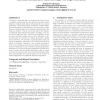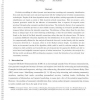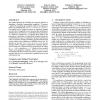47 search results - page 9 / 10 » The Use of Group Delay Features of Linear Prediction Model f... |
KDD
2006
ACM
14 years 6 months ago
2006
ACM
Correlation clustering aims at grouping the data set into correlation clusters such that the objects in the same cluster exhibit a certain density and are all associated to a comm...
ICML
2010
IEEE
13 years 7 months ago
2010
IEEE
Dimension reduction is popular for learning predictive models in high-dimensional spaces. It can highlight the relevant part of the feature space and avoid the curse of dimensiona...
MICCAI
2010
Springer
13 years 4 months ago
2010
Springer
The high dimensionality of functional magnetic resonance imaging (fMRI) data presents major challenges to fMRI pattern classification. Directly applying standard classifiers often ...
DATAMINE
2008
13 years 4 months ago
2008
Predictive modelling of online dynamic user-interaction recordings and community identifi cation from such data b ecomes more and more imp ortant w ith th e w idesp read use of on...
SIGSOFT
2007
ACM
14 years 7 months ago
2007
ACM
The standard language for describing the asymptotic behavior of algorithms is theoretical computational complexity. We propose a method for describing the asymptotic behavior of p...



